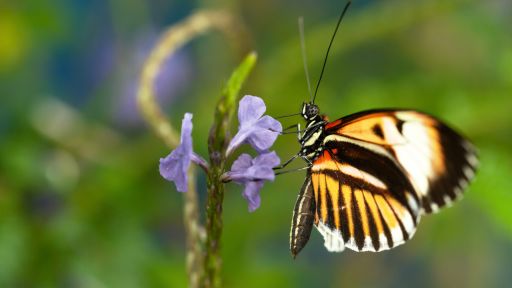Monarch butterflies have one of the world’s most fascinating migration paths. Every fall, thousands of the black-and-orange butterflies fly west to their wintering grounds in California and Mexico, covering the trees there with their bright shimmering wings. The remarkable sight attracts scores of tourists: Pacific Grove, CA, has earned the nickname “Butterfly Town, U.S.A.” for the host of Monarchs that gather there every year. Come spring, the butterflies fly back to their summer homes, where they will lay eggs and die. A typical butterfly will make just one round trip during its lifetime.
For centuries, people puzzled over exactly where the millions of Monarchs that spend their winters in Mexico and California came from. But in 1937, a researcher named F. A. Urquhart began putting wing tags on the butterflies, allowing him to track some of the travelers. In the 1950s, he expanded the project, enlisting more than 3,000 volunteers across the country in his Insect Migration Association. For more than 20 years, the volunteers helped track the marked insects, contacting Urquhart whenever they found or saw a marked Monarch.
The results of the tracking project astounded many people. One tagged butterfly was tracked along a 1,870-mile route. Originally tagged on September 18, 1957 in Highland Creek, Ontario, it was spotted again in San Luis Potosi, Mexico, four months later. Of course, the butterfly’s actual flight distance was even longer than a map suggests, because the insects don’t fly in a straight line. They must dodge mountains, fight against winds, and flee predators on their perilous journeys.
Today, thousands of people continue to tag monarchs in an effort to study their migration. In 1997, for instance, the research organization Monarch Watch helped volunteers place small sticky wing tags on more than 75,000 butterflies. And in 1998, it distributed more than 200,000 tags to people interested in helping out with the annual tracking project. While the group isn’t sure how many of the 1998 tags actually made it onto butterflies’ wings, at least 35 marked monarchs were spotted at their wintering grounds in Mexico. One had flown at least 1,844 miles southwest from where it was tagged in Campbell, MN, to its roosting spot in El Rosario, Mexico. But some tagged monarchs took off in unexpected directions. One butterfly flew about 550 miles due west from western Kentucky to Lindsborg, KS, where trackers Grant Linder and Hannah Giles spotted it.








